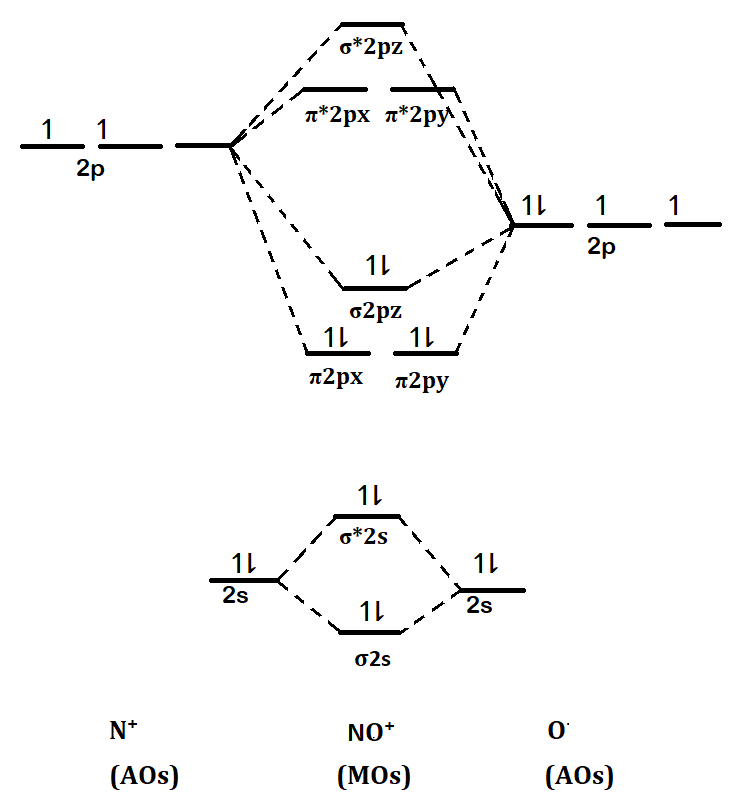Answer
35.4k+ views
Hint: Bond order is the difference between the number of bonding and anti bonding electrons, divided by two. So first find out the total number of electrons present in $N{O^ + }$ ion and write down its configuration. From this find out the number of bonding and anti bonding electrons and use them in the formula.
Formula used:
Bond order: BO = $\dfrac{1}{2}$ (Bonding electrons – Anti bonding electrons) (1)
Complete step by step answer:
- First we will talk about the Molecular orbital theory.
In the molecular orbital theory the electronic configuration or structure of the molecules by the use of quantum mechanics. Atomic orbitals combine and form molecular orbitals. According to this theory:
(1)The total number of atomic orbitals will be equal to the total number of molecular orbitals.
(2)The molecular orbitals are of 3 types: bonding molecular orbitals, non-bonding molecular orbitals and anti-bonding molecular orbitals. The energy of the anti-bonding molecular orbitals is more than the energy of the parent orbitals and the energy of the bonding molecular orbitals is always lower than the parent orbitals.
(3)The electrons are filled in the molecular orbitals according to the increasing order of energy.
(4)When the combining atomic orbitals have similar energies, the molecular orbitals formed are most effective.
-Now let us see what bond order is.
Bond order is basically the difference between the number of bonding and anti bonding electrons, divided by two. Mathematically it can be written as:
BO = $\dfrac{1}{2}$ (Bonding electrons – Anti bonding electrons) (1)
Now we will check the number of atoms present in $N{O^ + }$.
The number of electrons in this molecules will be = 7 + 8 – 1 = 14 electrons
Hence its electronic configuration will be: $\sigma 1{s^2}, \sigma *1{s^2}, \sigma 2{s^2}, \sigma *2{s^2}, \pi 2p{x^2}, \pi 2p{y^2}, \sigma 2p{z^2}$
Its molecular orbital diagram will be as follows:

Here we can see that the number of bonding electrons are = 8; and the number of anti bonding electrons are = 2.
Now using equation (1) we will find out its bond order:
BO = $\dfrac{1}{2}$ (Bonding electrons – Anti bonding electrons)
= $\dfrac{1}{2}$ (8 – 2)
= 3
Hence the correct option will be: (A) 3
Note: The MOT explains the existence of a molecule on the basis of bond order, but this concept is neither feasible nor appropriate to explain molecular existence of polyatomic molecules. Also MOT does not say anything about the geometry and shape of the molecule. So, this theory also has some drawbacks.
Formula used:
Bond order: BO = $\dfrac{1}{2}$ (Bonding electrons – Anti bonding electrons) (1)
Complete step by step answer:
- First we will talk about the Molecular orbital theory.
In the molecular orbital theory the electronic configuration or structure of the molecules by the use of quantum mechanics. Atomic orbitals combine and form molecular orbitals. According to this theory:
(1)The total number of atomic orbitals will be equal to the total number of molecular orbitals.
(2)The molecular orbitals are of 3 types: bonding molecular orbitals, non-bonding molecular orbitals and anti-bonding molecular orbitals. The energy of the anti-bonding molecular orbitals is more than the energy of the parent orbitals and the energy of the bonding molecular orbitals is always lower than the parent orbitals.
(3)The electrons are filled in the molecular orbitals according to the increasing order of energy.
(4)When the combining atomic orbitals have similar energies, the molecular orbitals formed are most effective.
-Now let us see what bond order is.
Bond order is basically the difference between the number of bonding and anti bonding electrons, divided by two. Mathematically it can be written as:
BO = $\dfrac{1}{2}$ (Bonding electrons – Anti bonding electrons) (1)
Now we will check the number of atoms present in $N{O^ + }$.
The number of electrons in this molecules will be = 7 + 8 – 1 = 14 electrons
Hence its electronic configuration will be: $\sigma 1{s^2}, \sigma *1{s^2}, \sigma 2{s^2}, \sigma *2{s^2}, \pi 2p{x^2}, \pi 2p{y^2}, \sigma 2p{z^2}$
Its molecular orbital diagram will be as follows:

Here we can see that the number of bonding electrons are = 8; and the number of anti bonding electrons are = 2.
Now using equation (1) we will find out its bond order:
BO = $\dfrac{1}{2}$ (Bonding electrons – Anti bonding electrons)
= $\dfrac{1}{2}$ (8 – 2)
= 3
Hence the correct option will be: (A) 3
Note: The MOT explains the existence of a molecule on the basis of bond order, but this concept is neither feasible nor appropriate to explain molecular existence of polyatomic molecules. Also MOT does not say anything about the geometry and shape of the molecule. So, this theory also has some drawbacks.
Recently Updated Pages
To get a maximum current in an external resistance class 1 physics JEE_Main

If a wire of resistance R is stretched to double of class 12 physics JEE_Main

Let f be a twice differentiable such that fleft x rightfleft class 11 maths JEE_Main

Find the points of intersection of the tangents at class 11 maths JEE_Main

For the two circles x2+y216 and x2+y22y0 there isare class 11 maths JEE_Main

The path difference between two waves for constructive class 11 physics JEE_MAIN

Other Pages
Dissolving 120g of urea molwt60 in 1000g of water gave class 11 chemistry JEE_Main

Electric field due to uniformly charged sphere class 12 physics JEE_Main

Excluding stoppages the speed of a bus is 54 kmph and class 11 maths JEE_Main

Differentiate between homogeneous and heterogeneous class 12 chemistry JEE_Main

The strongest oxidising agent among the following is class 11 chemistry JEE_Main

Explain the construction and working of a GeigerMuller class 12 physics JEE_Main



